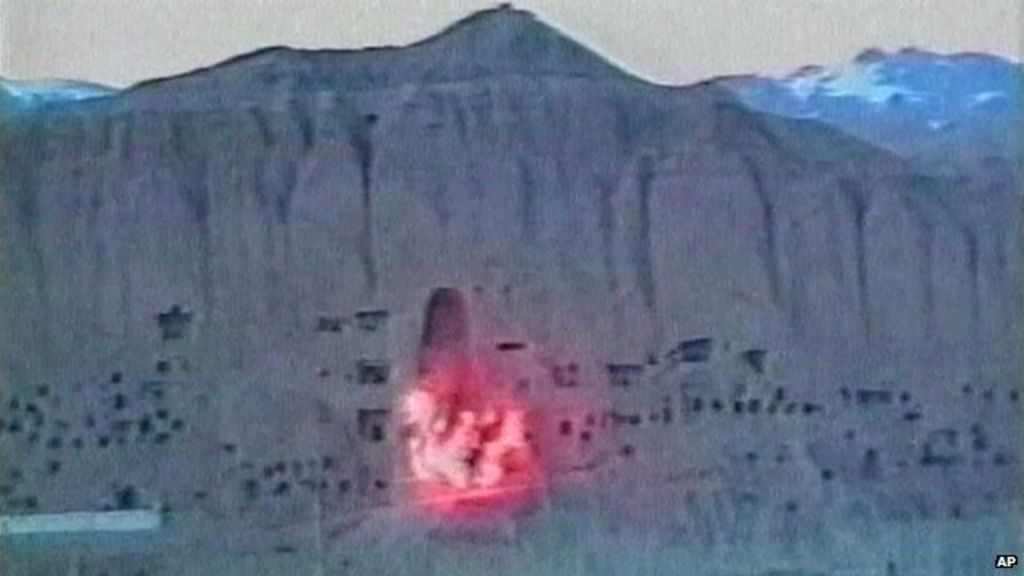THE SADNESS OF THINGS
The sarcasm of birds:
two crows bickering on the empty bird table.
The disappointment of biscuits:
too sweet and crumbly for middle-age.
The distraction of other things:
screens flickering, new music demanding attention.
The disintegration of light:
darkness reflected in a discoloured mirror.
The enigma of memory:
what I remember, what I choose to forget.
The destruction of history:
ancient monuments deliberately reduced to dust.
The seduction of the unknown
rather than what we should care for and love.
The impossibility of calm
and quiet and order, of making a perfect home.
The absence of speech:
words unrecognisable, books left out in the rain.
The elusiveness of meaning:
playful disjunction is not the same as synchronicity.
The sarcasm of birds,
their caws and cries waking me up too soon.
The drawn-out day:
silences, pauses, worry and dismay.
The fickleness of language,
refusing to mean what I want to say.



destruction of Bamiyan Buddha
The sarcasm of birds:
two crows bickering on the empty bird table.
The disappointment of biscuits:
too sweet and crumbly for middle-age.
The distraction of other things:
screens flickering, new music demanding attention.
The disintegration of light:
darkness reflected in a discoloured mirror.
The enigma of memory:
what I remember, what I choose to forget.
The destruction of history:
ancient monuments deliberately reduced to dust.
The seduction of the unknown
rather than what we should care for and love.
The impossibility of calm
and quiet and order, of making a perfect home.
The absence of speech:
words unrecognisable, books left out in the rain.
The elusiveness of meaning:
playful disjunction is not the same as synchronicity.
The sarcasm of birds,
their caws and cries waking me up too soon.
The drawn-out day:
silences, pauses, worry and dismay.
The fickleness of language,
refusing to mean what I want to say.



destruction of Bamiyan Buddha
Bamiyan is in the Hazarat region of Afghanistan. It was a Buddhist religious site from the 2nd century up to the time of the Islamic invasion in the later half of the 7th century, a thriving center for religion, philosophy, and art. The bott-haye Bamiyan were the largest standing Buddha carvings in the world. They were carved directly into a sandstone cliff, but details were modeled in mud mixed with straw, coated with stucco and painted to enhance the expressions of the faces, hands, and folds of the robes. Wooden pegs placed in holes stabilized the outer stucco. The lower parts of the statues' arms were constructed from the same mud-straw mix, supported on wooden armatures, while the upper parts of their faces were made from wooden masks or casts. The 53-m (174-ft) "Solsol, Light Shines Through the Universe" (actually Buddha Vairocana) was built in 554, and the 35-m (115-ft)"Shahmama, Queen Mother" (Buddha Sakyamuni) in 507. The larger one was once carmine red, and the smaller one painted multiple colors, but almost all of the paint wore away over time. The Chinese Buddhist monk Xuanzang visited in 630 and described Bamiyan as having "more than ten monasteries and more than a thousand monks" and noted that both statues were "decorated with gold and fine jewels." He also mentioned an even larger reclining statue of the Buddha. (His travels throughout Asia became the basis of Wu Cheng'en's 16th-century "Journey to the West," also known as "Monkey.") In the 17th centurt the Moghul emperor Muhi-ud-Din Muhammad ("Aurangzeb") tried to destroy the statues with artillery, as did Nader Shah Afshar of Persia a 1/2 century later. In the late 1880s the Hazara tribes revolted against amir Abdur Rahman Khan of Afghanistan; he brutally suppressed them, resulting in the killing or displacement of about 60% of their population and the destruction of Solsol's face. In 1998 a local Taliban leader Abdul Wahed drilled holes in their heads to place explosives, but Mulla Muḥammad 'Umar prevented their destruction. However, as the Talibam became more zealous in their attempts to strictly enforce Sharia (Muslim law) he had them destroyed in March 2001; it took most of the month to complete the project. The mullah claimed, "Muslims should be proud of smashing idols. It has given praise to Allah that we have destroyed them."
ReplyDelete